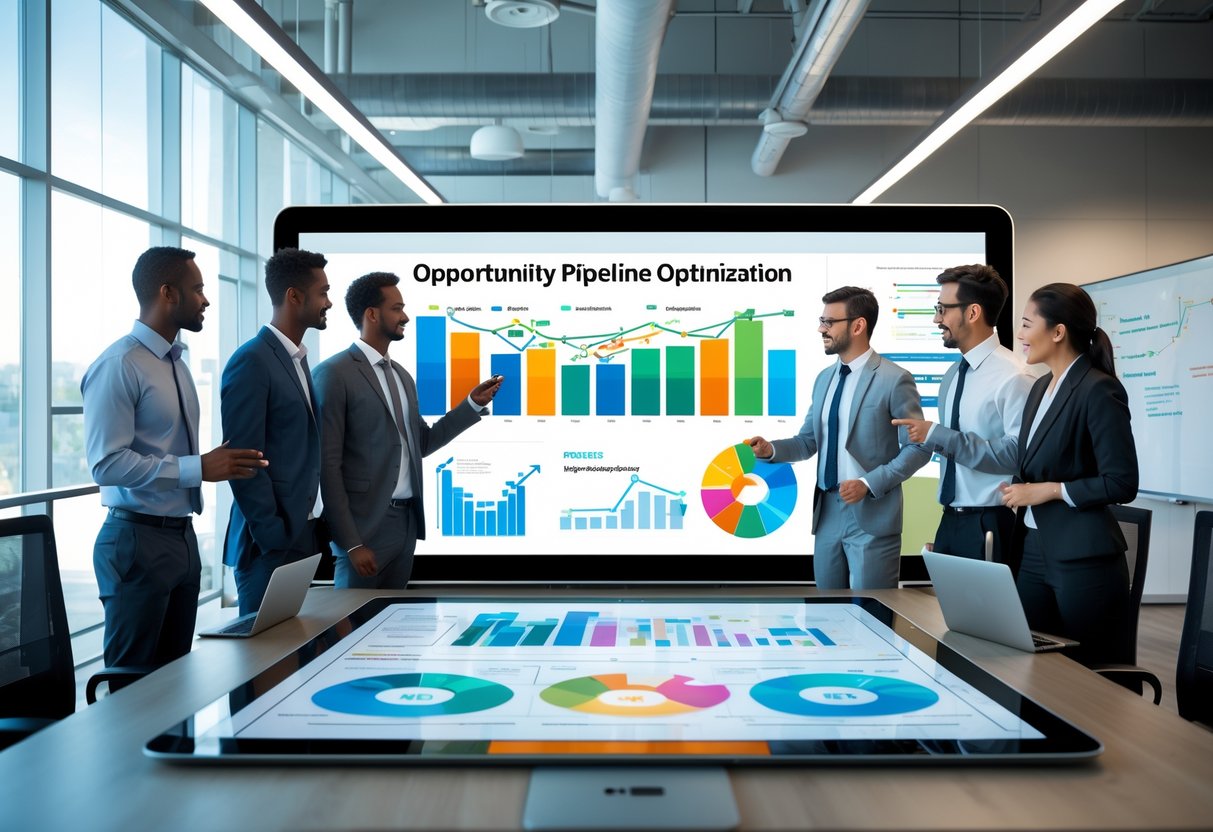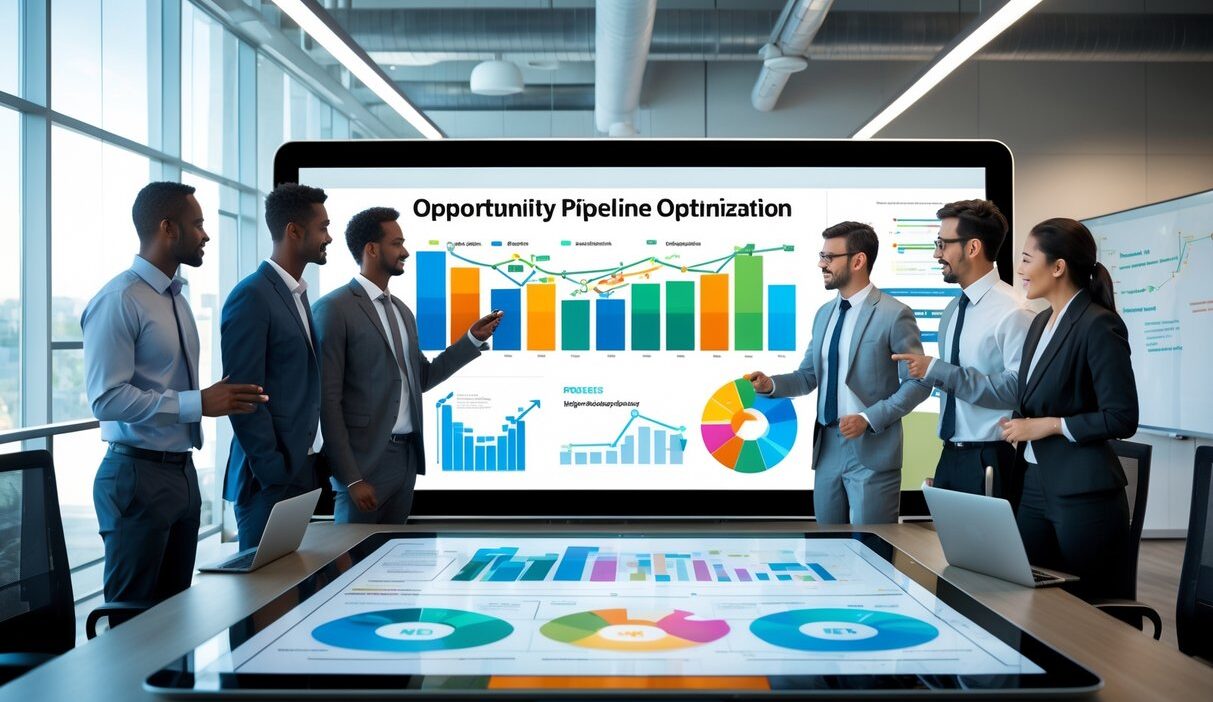When I think about growing sales, I know managing opportunities is just as important as finding them. An opportunity pipeline shows me where every deal stands and what actions will move it forward.
Optimizing this pipeline means I focus on the right deals, improve forecasting, and close more business with less wasted effort.

I use data and clear steps to remove guesswork. Instead of chasing every lead, I prioritize the ones most likely to convert and quickly spot deals that won’t move.
With the right approach, I can streamline the process and shorten sales cycles. Better decisions at every stage just come easier.
By treating pipeline management as a system, I gain control and clarity. This lets me act faster and adjust strategies when needed.
Key Takeaways
- Opportunity pipeline optimization focuses on clarity and efficiency
- Strong pipelines rely on prioritization and measurable actions
- Consistent tracking and improvements lead to higher win rates
Understanding Opportunity Pipeline Optimization
I see opportunity pipeline optimization as a way to make sales more predictable. It helps me spot where deals stand, how likely they are to close, and what to do next.
Key Concepts and Definitions
When I talk about an opportunity pipeline, I mean a structured view of all potential deals in progress. Each deal moves through defined stages—qualification, proposal, negotiation, closing.
Optimization is about improving how these stages are managed. This includes tracking deal value, probability of closing, and expected timelines.
A pipeline acts like a real-time snapshot of sales activity, similar to what Cliently describes as a critical step in opportunity management. To optimize, I stick to clear definitions for each stage and status.
If “qualified lead” means different things to different people, measuring progress gets messy. Standardized terms keep everyone aligned.
I also use CRM tools to automate updates and keep data accurate. This cuts down on manual errors and keeps the pipeline reliable for forecasting.
Importance in Modern Sales Processes
An optimized pipeline gives me visibility into revenue potential and helps me allocate resources. It shows not just how many deals exist, but which ones are most likely to close.
In today’s sales world, I need more than just tracking leads. A well-structured pipeline becomes a system for growth, as noted in effective pipeline management practices.
With accurate data, I can forecast sales more confidently. That means smarter planning around staffing, budgets, and marketing.
It also helps me spot weak points. If deals stall at a certain stage, I know where to focus training or process tweaks.
This level of insight is essential for competitive industries where timing and follow-up really matter.
Common Challenges in Pipeline Management
I often see trouble when pipeline data is incomplete or outdated. If team members don’t update deal stages, the pipeline loses its value.
Another issue is overstuffing the pipeline with low-quality opportunities. Without proper qualification, I waste time on deals that won’t close.
Some organizations struggle with defining clear stages. If “in progress” means different things to different people, reporting falls apart.
According to GrowthMap’s guidance on stages and statuses, customizing and standardizing terms is crucial for consistency.
Many teams also overlook analytics. Without tracking conversion rates, deal velocity, and win probability, it’s tough to spot bottlenecks.
If you don’t want to deal with all these headaches, feel free to contact me on Whatsapp for consultation or to buy quality leads: +917303556188. Why work so hard? Let me handle it for you.
Core Components of an Optimized Opportunity Pipeline
I focus on three main elements when optimizing an opportunity pipeline: clear lead qualification rules, structured sales stages, and accurate data.
Each of these cuts wasted effort and keeps deals moving forward.
Lead Qualification Criteria
I use qualification criteria to decide which opportunities deserve my attention. Without clear standards, I might chase leads that will never close.
I look at things like budget, authority, need, and timeline (BANT). These help me figure out if a prospect is ready and able to buy.
For complex sales, I might use frameworks like MEDDIC or CHAMP to dig deeper into the decision process.
I also track engagement signals—email responses, meeting attendance, content downloads. These show me if a lead is actually interested.
By applying consistent rules, I avoid clogging my pipeline with bad prospects. This keeps my close rate up and my revenue picture clearer.
Pipeline Stages and Milestones
I break my pipeline into defined stages so I know where each opportunity stands. A typical structure includes prospecting, qualification, meeting, proposal, negotiation, and closed-won or closed-lost.
Salesforce calls this a visual representation of the sales process.
Each stage has milestones that signal progress. For example:
- Prospecting: initial outreach done
- Qualification: lead meets budget and authority criteria
- Proposal: formal offer delivered
- Negotiation: pricing or terms discussed
I keep these milestones clear and measurable. That way, there’s less confusion and I can spot delays quickly.
When I review my pipeline, I see which deals are stuck and why. This makes it easier to adjust my strategy.
Data Quality and Accuracy
I rely on accurate data to make decisions. If my pipeline is full of outdated info, my forecasts are worthless.
I make sure every opportunity record includes contact details, deal size, expected close date, and stage. Missing or inconsistent data weakens my ability to prioritize.
Regular reviews help me clean up errors. I remove duplicates, update stale records, and check that deal values and timelines make sense.
Using CRM tools also improves accuracy. Systems like sales pipeline management software automate data entry, track activity, and flag missing fields.
This reduces mistakes and keeps my pipeline trustworthy.
If you want a pipeline that’s always up to date and full of real opportunities, just reach out on Whatsapp: +917303556188. You’ll save yourself a lot of hassle.
Strategies for Improving Pipeline Performance

I focus on three main areas when improving pipeline performance: choosing the right opportunities, using tools that cut busywork, and keeping deals from stalling.
Each area directly affects how efficiently I can move prospects toward a decision.
Prioritization and Segmentation
I start by ranking opportunities based on their likelihood to close and their potential value. High-intent leads get more of my time.
This prevents me from spreading my effort too thin. I use historical data and current activity—deal size, buying signals, past interactions.
Segmenting prospects into clear groups—like high-value accounts versus smaller deals—lets me tailor my approach.
I also disqualify weak opportunities early. If a lead isn’t showing real buying intent, I move on.
Tools like sales pipeline management strategies stress the importance of setting clear criteria for qualifying and prioritizing leads.
Automation and Technology Integration
I use automation for follow-ups, reminders, and reporting. This frees me up for conversations that matter.
Automating email sequences keeps outreach consistent without eating up my day.
Integrating AI-powered tools helps me make better decisions. With predictive insights, I can see which leads are most likely to convert.
Microsoft shows how AI-driven pipeline optimization improves forecasting and lead qualification by analyzing real-time data.
I also connect my CRM with marketing platforms. This gives me a full view of customer behavior.
The more my tools talk to each other, the faster I can respond to opportunities.
Pipeline Velocity Enhancement
I pay attention to how fast deals move through each stage. If prospects get stuck, I find the bottleneck and adjust.
Sometimes this means giving clearer info earlier or scheduling follow-ups sooner.
I track the average time deals spend in each stage. If a stage always causes delays, I refine the process.
Maybe I create standardized templates for proposals to speed things up.
I focus on keeping momentum with prospects. Quick responses, clear next steps, and regular check-ins keep deals moving.
As pipeline velocity strategies explain, removing friction improves win rates and shortens the sales cycle.
If you’d rather skip the trial and error and just get leads that move fast, contact me on Whatsapp: +917303556188. Honestly, it’s a lot easier.
Metrics and KPIs for Pipeline Optimization

I focus on measurable indicators that show how efficiently deals move through the pipeline, how reliable my forecasts are, and how long it takes to close opportunities.
These numbers show me where to tweak processes or shift resources.
Conversion Rates Analysis
I track conversion rates at each stage to see how well leads move through the pipeline. For example, I watch the percentage of Marketing Qualified Leads (MQLs) that become Sales Qualified Opportunities (SQOs).
Key ratios I monitor include:
- Lead to Opportunity Conversion Rate
- Opportunity to Customer Win Rate
A low lead-to-opportunity rate may mean poor lead quality or unclear qualification. A low win rate often points to sales execution issues.
I compare my numbers against industry benchmarks. According to pipeline metrics research, top B2B companies average around 11–12% lead-to-opportunity conversion.
If I fall below this, I know I need to adjust targeting or improve the sales handoff.
Forecast Accuracy
Accurate forecasting depends on weighting deals by stage and probability. I use Weighted Pipeline Value, applying close probabilities to each opportunity.
Formula:
Σ (Deal Value × Stage Probability)
This gives me a reality-adjusted forecast. If my weighted pipeline is less than 80% of target, I know I’m at risk of missing goals.
If it’s above 120%, I check for overly safe assumptions.
I also calculate my Pipeline Coverage Ratio by dividing pipeline value by revenue quota. A healthy ratio is usually around 3:1, though enterprise sales often need 4–5x coverage.
As outlined in pipeline KPI guides, this metric is one of the best early warning signs for revenue shortfalls.
Deal Cycle Time Measurement
I measure the average time it takes for an opportunity to move from qualification to closed-won. This deal cycle time shows if my process is efficient or if deals stall at certain stages.
I break the cycle into segments, such as:
- Qualification → Proposal
- Proposal → Negotiation
- Negotiation → Closed
If one stage drags on, I know where to focus improvements. Maybe I need better sales enablement materials.
Shorter cycles usually mean better win rates because prospects lose interest less often. But I don’t push speed at the cost of quality.
Tracking cycle time alongside win rate helps me balance efficiency with effectiveness.
By monitoring these timelines, I can forecast capacity more accurately and plan resources around realistic sales velocity.
If all this sounds like a headache, just message me on Whatsapp at +917303556188 for a consultation or to buy leads. Seriously, why make it harder than it has to be?
Advanced Techniques and Best Practices

I’m always hunting for smarter ways to keep my opportunity pipeline moving. By leaning on predictive insights and regular reviews, I can cut down on wasted effort and actually close more deals.
I’m not just guessing anymore. Predictive analytics help me spot which opportunities are most likely to close.
Instead of chasing every maybe, I let data guide me—things like past deal outcomes, engagement levels, and those subtle buying signals that really matter.
With AI-powered tools, like what you get in Microsoft Dynamics 365 Sales, I get real-time recommendations.
These tools score leads, suggest next steps, and even take a first pass at drafting outreach.
I find that this saves me hours I’d otherwise spend on dead-end prospects.
I also track live deal activity for forecasting, not just the old data. That way, I get a sharper sense of my revenue picture and can tweak my approach before things go off track.
I make it a point to review my pipeline all the time—weekly or bi-weekly works best. If you let it sit, it goes stale fast.
I check deal progress. Did it move at all, or is it stuck?
Then I look at engagement. Are folks replying to emails or picking up the phone?
And do I have actual next steps planned, or am I just hoping something will happen?
If I see a deal going nowhere, I drop it. No point in clogging up the system with old leads.
I’ve noticed that when sales and marketing teams actually talk, results get better. Marketing brings in leads, I give feedback, and together we improve the quality over time.
We use shared data platforms, so there’s no confusion about who owns what. It keeps everyone honest and the messaging consistent.
When we plan together—say, marketing targets a new industry—I get ready with pitches that fit. This teamwork speeds up the sales cycle and helps us win more often.
If you’re tired of grinding it out and want to skip right to the good leads, just reach out to me. Feel free to contact me on WhatsApp for consultation or to buy leads: +917303556188. Seriously, why work so hard when you could just get qualified leads from someone who’s already done the heavy lifting?
Frequently Asked Questions
Structured sales practices, clear templates, and the right tools help me keep my pipeline in shape. Lead qualification and pipeline health matter if you want to see real results.
How can sales pipeline management best practices improve conversion rates?
When I stick with regular updates, clear stage definitions, and solid follow-ups, I don’t waste time. Qualified leads move faster, and I see better conversion rates.
According to FasterCapital, tracking metrics like conversion rate and win rate really does make a difference.
What are the key components of an effective opportunity pipeline template?
A good template breaks things down: lead generation, qualification, proposal, negotiation, and closing.
I always add probabilities, time frames, and expected values for each stage. It gives me a straight-up view of where every deal stands.
In what ways do pipeline management tools enhance sales forecasting accuracy?
I use pipeline tools to track progress and update stages. Real-time data gives me better revenue forecasts.
Dashboards and reports make it easier to spot bottlenecks and fix things before they get messy.
What strategies are essential for maintaining a healthy sales pipeline?
I qualify leads, nurture prospects, and clear out the ones that have gone cold. Regular reviews keep my data fresh.
This guide on pipeline strategies says cleaning up stale opportunities is key. I’ve found that to be true.
How does lead qualification impact opportunity pipeline management?
Lead qualification stops me from wasting time on long shots. I use frameworks like BANT or scoring models to focus on high-value leads.
That way, I put my energy into deals that actually have a shot at closing.
Don’t want to spend your days chasing leads that go nowhere? Feel free to contact me on WhatsApp at +917303556188 for consultation or to buy leads. It’s just easier to get leads from someone who’s already done the groundwork.
What differentiates opportunity management from pipeline management in a sales context?
Opportunity management is all about handling each deal one by one. You’re nurturing leads, negotiating, and, hopefully, closing that sale.
Pipeline management zooms out and looks at the whole flow of opportunities at every stage. It’s more about tracking the big picture—where deals stand, what’s stuck, and what’s moving.
Yeah, they’re connected, but they don’t do the same job. Microsoft breaks it down pretty well in their opportunity management FAQs.
If you’re tired of juggling all this yourself, why not just let me handle the hard part? You can feel free to contact me on WhatsApp at +917303556188 for consultation or if you want to buy quality leads. Honestly, why work so hard when I can send the leads straight to you?



